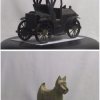Free Online Productivity Tools
i2Speak
i2Symbol
i2OCR
iTex2Img
iWeb2Print
iWeb2Shot
i2Type
iPdf2Split
iPdf2Merge
i2Bopomofo
i2Arabic
i2Style
i2Image
i2PDF
iLatex2Rtf
Sci2ools
ICCV
2005
IEEE
2005
IEEE
Evaluation of Features Detectors and Descriptors Based on 3D Objects
We explore the performance of a number of popular feature detectors and descriptors in matching 3D object features across viewpoints and lighting conditions. To this end we design a method, based on intersecting epipolar constraints, for providing ground truth correspondence automatically. We collect a database of 100 objects viewed from 144 calibrated viewpoints under three different lighting conditions. We find that the combination of Hessian-affine feature finder and SIFT features is most robust to viewpoint change. Harris-affine combined with SIFT and Hessianaffine combined with shape context descriptors were best respectively for lighting changes and scale changes. We also find that no detector-descriptor combination performs well with viewpoint changes of more than 25-30 .
Computer Vision | ICCV 2005 | Popular Feature Detectors | Shape Context Descriptors | SIFT Features | Viewpoint Changes |
Related Content
| Added | 15 Oct 2009 |
| Updated | 30 Oct 2009 |
| Type | Conference |
| Year | 2005 |
| Where | ICCV |
| Authors | Pierre Moreels, Pietro Perona |
Comments (0)

